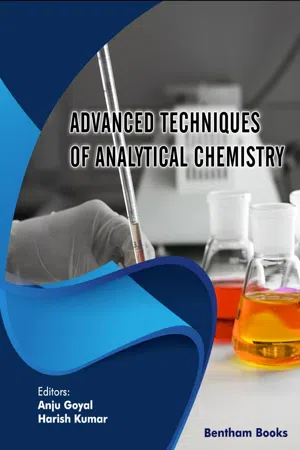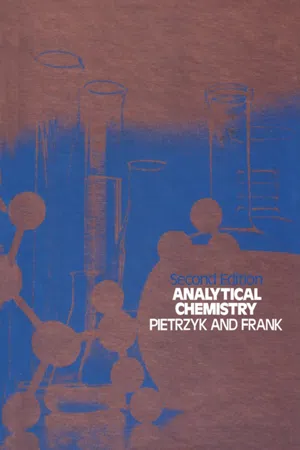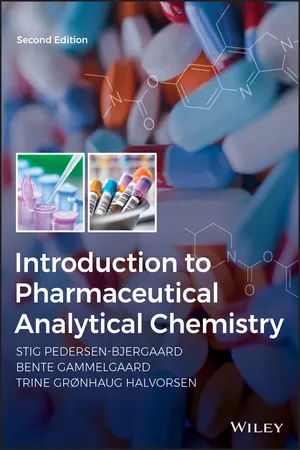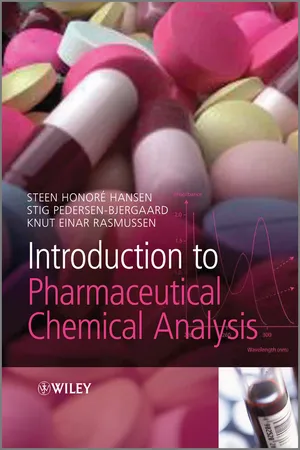Chemistry
Redox Titration
Redox titration is a type of titration that involves the transfer of electrons between the reactants. It is used to determine the concentration of an unknown solution by comparing it to a standard solution of known concentration. The endpoint of the titration is reached when the reaction between the two solutions is complete.
Written by Perlego with AI-assistance
Related key terms
Related key terms
1 of 4
Related key terms
1 of 3
5 Key excerpts on "Redox Titration"
- Anju Goyal, Harish Kumar(Authors)
- 2022(Publication Date)
- Bentham Science Publishers(Publisher)
Redox TitrationsSapna Kumari,1 , *Anju Goyal1,Madhukar Garg11 Chitkara College of Pharmacy, Chitkara University, Rajpura, Punjab, IndiaAbstract
Redox Titrations are the titrimetric method developed to know the concentration of the analyte by creating redox reaction among titrant and analyte. The basic principle involved in the Redox Titration is the oxidation-reduction reaction, in which electron transfer from one reactant to another reactant takes place. Oxidation means loss of electron and reduction means gain of electron. These must happen at the same time, when a substance loses electrons, there must be some other substance to accept those electrons. The main applications associated with Redox Titrations are determining the reduction potential of sHdrA flavin from Hyphomicrobium denitrificans, water in non-aqueous solutions, dissolved oxygen in water and determination of alcohol content in the whiskey bottles, etc.Keywords: Oxidation, Redox Titrations, Reduction, Titrimetric methods.* Corresponding author Sapna Kumari: Chitkara College of Pharmacy, Chitkara University, Rajpura, Punjab, India; E-mail: [email protected]INTRODUCTION
Redox Titrations are the titrimetric method based upon the electron transfer between the reactants or change in the oxidation number of the reactant. Popularly, these are well known as oxidation-reduction titrations, as these involve the titration of the reducing agent with a standard solution of an oxidizing agent and vice versa. Most commonly, this method is used in the laboratory for determining the concentration of a given analyte via triggering a redox reaction between the analyte and the titrant. Sometimes, these types of titrations needed a potentiometer or a redox indicator to identify unknown analytes [1 ].History And Development Of Redox Titration Method
Redox Titrations were announced just after the progression of acid–base titrimetry. The initial methods acquired the benefit of the oxidizing power of chlorine. In 1787, Claude Berthollet introduced a new method for the analysis of chlorine water (a mixture of Cl2- eBook - ePub
- Clyde Frank(Author)
- 2012(Publication Date)
- Academic Press(Publisher)
Chapter ElevenOxidation–Reduction Titrations
Publisher Summary
A redox reaction is used for a titration and meets the general requirements that apply to other successful titration procedures. Many different inorganic species exist in more than one stable oxidation state and can frequently be determined through a Redox Titration. Certain organic functional groups are quantitatively oxidized or reduced and are analyzed by a titration procedure. This chapter discusses the feasibility of Redox Titrations and end-point detections by color indicators and potentiometry. Redox reactions tend to be slow, and often the redox reaction becomes useful after a suitable catalyst becomes available. The chapter also explains the Redox Titration curve, which describes the change in concentration of the species of interest as a function of the titrant. It is possible to predict the shape of a titration curve prior to carrying out the titration in the laboratory.INTRODUCTION
If a redox reaction is to be used for a titration, it must meet the same general requirements that apply to other successful titration procedures. Consequently, the reaction should be rapid, go to completion, be stoichiometric, and a means for end-point detection should be available. Many different inorganic species exist in more than one stable oxidation state and frequently can be determined through a Redox Titration. Similarly, certain organic functional groups are quantitatively oxidized or reduced and can, therefore, be analyzed by a titration procedure. In this chapter the feasibility of Redox Titrations and end-point detection by color indicators and potentiometry are considered.In general, redox reactions tend to be slow and often the redox reaction only becomes useful after a suitable catalyst becomes available. For example, the best way to standardize Ce4+ solutions is by titrating primary standard As2 O3 [tris-1,10-phenthroline iron (II) is used as indicator]. However, poor results are obtained because the reaction rate is too slow. If OsO4 is added as a catalyst, the reaction proceeds conveniently and an accurate standardization is obtained. It is difficult to generalize in regard to useful catalysts for redox reactions. Some are catalyzed by acid, others by base, and still others by metal ions. Also, there are reactions, such as Fe2+ –Ce4+ , I2 –S2 O3 2− , BrO− –Br− - Stig Pedersen-Bjergaard, Bente Gammelgaard, Trine G. Halvorsen(Authors)
- 2019(Publication Date)
- Wiley(Publisher)
Redox Titrations. A Redox Titration can be described by the following equation:(5.18)The subscript 1 refers to the titrate and 2 refers to the titrant, respectively. The reduction potential of a given substance is an expression of the extent to which the substance may take up electrons. A high positive value for the reduction potential indicates:- The substance is easily reduced.
- The substance is a powerful oxidizing agent.
- The substance easily removes electrons from other substances with a lower reduction potential.
Table 5.3 list values for standard reduction potentials (E0 ) for typical redox pairs.Table 5.3Standard reduction potentials (E0 )Oxidized form Reduced form E0 (V)Ce4+ + e−Ce3+1.61 MnO4 − + 5e− + 8H+ Mn2+ + 4H2 O1.51 Fe3+ + e−Fe2+0.55 Br2 + 2e−2Br−1.05 I2 + 2e−2I−0.54 2H+ + 2e−H20.00 Fe2+ + 2e−Fe −0.44 Ca2+ + 2e−Ca −2.89 A substance with a higher reduction potential oxidizes a compound with a lower reduction potential. For titrations in general, the equilibrium constant should be high to ensure a complete reaction. In Redox Titration, the equilibrium constant is determined by the difference (ΔE) between the reduction potentials of the two substances:(5.19)E0 T is the reduction potential of the titrant and E0 A is the reduction potential of the analyte (titrate). ΔE is termed the reaction potential. In practice, ΔE should not be less than 0.1–0.2 V. Throughout titration, the potential changes gradually with addition of the titrant, and at the equivalence point the potential increases or decreases very sharply as a function of the added titrant. An example of this is shown in Figure 5.11 for the titration of iron (II) (Fe2+ ) with cerium (IV) (Ce4+- eBook - ePub
- Steen Honoré Hansen, Stig Pedersen-Bjergaard, Knut Rasmussen(Authors)
- 2011(Publication Date)
- Wiley(Publisher)
Chapter 5 Titrimetric Methods5.1 IntroductionThis chapter discusses the principles of quantitative analysis based on titrimetric methods. Titrimetric methods are official methods in the European Pharmacopeia and are used for quality control of active pharmaceutical ingredients (APIs) and excipients. The chapter focuses on titrations based on acid–base reactions and redox reactions and also gives an overview of various principles of endpoint detection. Examples of titrimetric methods for the quantitative determination of APIs and excipients are discussed in Chapter 21.In titrimetric methods the volume of a reagent needed to react with an analyte is normally measured. To the analyte solution are added increments of a reagent solution (titrant ) of a precisely known concentration until the reaction between the reagent and the analyte is complete. The titrant is added either manually from a burette (see Figure 5.1 ) or from an automatic titration apparatus , so that the volume of titrant is controlled at all times during the titration .A titrimetric reaction can be illustrated by the following equation:Figure 5.1 Burette used for titration(5.1)where x and y is the number of moles of analyte and titrant needed to complete the titration. Titration is finished when virtually all the analyte has reacted and is transferred to products. The titration has reached the equivalence point . The amount of reagent consumed is read on the burette, and the quantity of analyte in the sample solution can be calculated on the basis of knowledge of the values of x and y . An example of such a calculation is shown in Box 5.1.Box 5.1 Calculation of the concentration of analyte in a titrimetric methodA sample solution of H2 SO4 of unknown concentration was titrated with a solution of 1.056 M NaOH to determine the molar concentration of H2 SO4 . 25.00 ml of the sample solution was titrated to the equivalence point with 23.55 ml of NaOH solution. H2 SO4 - eBook - ePub
- Justin P. Lomont, Ian C. Stewart(Authors)
- 2013(Publication Date)
- Visible Ink Press(Publisher)
Aqua regia translates to “royal water” in Latin, and it consists of a mixture of concentrated nitric and hydrochloric acids, typically in a 1 to 3 ratio, respectively. Since these are both strong acids, aqua regia can be quite dangerous and must be handled with extreme caution. This mixture is capable of dissolving several types of metals and has found many applications in chemistry, including the refinement of very high purity gold!What is an oxidation/reduction reaction?Oxidation and reduction reactions are chemical processes that involve the transfer of an electron between two species. Oxidation is the process of taking an electron away from a species, so if a molecule loses an electron, it has been oxidized. Reduction is the process of giving an additional electron to a species, so if a molecule gains an electron, it has been reduced. Oxidation and reduction reactions are particularly important in the field of electrochemistry.ELECTROCHEMISTRY
What is electrochemistry?Electrochemistry is a branch of chemistry that deals with electrons transferring between an interface and a molecule in an electrolyte solution. The interface is typically a conducting metallic material. Electrochemistry is a rich field that has led to the development of batteries, a widely used chemical separation technique called electrophoresis, a process for plating metals known as electroplating, and an immense body of knowledge surrounding oxidation-reduction chemistry, among other achievements.What is an electrochemical cell?One common example of a redox reaction in electrochemistry involves the transfer of electrons from zinc (Zn) metal to copper (Cu) ions in an electrochemical cell.Zinc (Zn) gives up electrons more readily than copper (Cu), so electrons spontaneously transfer from the Zn metal to the Cu metal, depositing Zn2+
Index pages curate the most relevant extracts from our library of academic textbooks. They’ve been created using an in-house natural language model (NLM), each adding context and meaning to key research topics.
Explore more topic indexes
Explore more topic indexes
1 of 6
Explore more topic indexes
1 of 4




